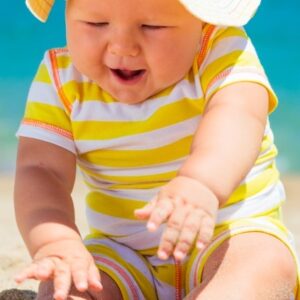Flying with a baby has its challenges. Quite a few of them, actually – the noise, the seats, the dry air, the tiny bathrooms… and the ear pain that can occur at take-off and landing!
Learning how to avoid ear pain in babies when flying is at least one of the things you can do for your little one!
My daughter screamed for hours (or at least that’s how it felt) when we flew her at the age of 4 months. It was such a nightmare. I have learned (the hard way) how to make the best of flying with a baby.
Why do babies and toddlers experience ear pain when flying?
Just like for adults, babies’ ears can hurt when cabin pressure changes.
Our ears adjust to air pressure changes through our “Eustachian tubes”, which connect the middle ear, behind the eardrum, to the back of the nose and throat. During takeoff and landing, we can feel pressure or even pain in our ears, and we might swallow or yawn to mitigate the pain. The Eustachian tubes open up by swallowing so our ears can adjust to the pressure more easily.
Babies and toddlers, however, have narrower Eustachian tubes, and sometimes they don’t open up as easily to equalize the pressure. This can cause even more pain than for adults. And, of course, it can be quite difficult to make a crying baby or a furious toddler swallow on command!
12 Things to Do to Avoid Ear Pain in Babies When Flying (and Toddlers too!)
We can’t always avoid ear pain in babies when flying entirely. Here are tips both to prevent and mitigate the pain and pressure for babies, toddlers, and a bit older children.
1. Breastfeeding
Breastfeeding (or bottle-feeding) is very efficient. And it is possible to do this even if your baby is sitting in the infant security belt provided.
Practice at home on how to breastfeed in public if the thought makes you at all uncomfortable. Your baby can otherwise sense your nervousness and might become fussier and more difficult to calm.
2. A pacifier
A pacifier also works – similar to how chewing gum works for adults. The suckling helps neutralize the ear pressure. If your baby does not accept a dummy yet, you can try these tips to help your baby take a pacifier.
3. Suckling or drinking anything
Babies who already know how to drink from a cup can do that too. You can even use your finger if it makes your baby suck and swallow.
4. Create a vacuum
You can also try pressing your hands against your baby’s ears to create a kind of vacuum. Then quickly take your hands away again. Practice on yourself first.
I once saw a flight attendant that pressed two mugs towards a child’s ears and then pulled away quickly. The child stopped crying immediately. This is the same thing as with your hands.
5. Something to eat
Older babies and toddlers can, of course, have some fruits or crackers to chew and swallow.
6. Something yummy
A bit older children who have been introduced to sugar can have a lollipop. Dum dum lollipops, for example, are small and hence the sugar intake is not huge. But this is of course only for kids who have already been introduced to candy! Flying is NOT a reason to start.
7. Chewing gum
Kids that are older than 3 years old can also try a chewing gum if you believe they are capable of just chewing and not swallowing.
8. Wait with the feeding
An important thing to remember is to NOT start any feeding too soon. Since takeoff can be delayed, there is a risk that your baby or toddler is full way before the swallowing is actually needed to avoid ear pain. Wait until the plane is actually rolling to take off.
9. Well hydrated child
Make sure that your child is well hydrated throughout the flight. Airplanes have very dry air and this can cause nasal congestion. Congestion in turn, can make the ear pain worse.
10. What About a Baby with a cold or allergies?
Is your child at all congested from a cold or allergies? If so, then prepare at home by asking the Dr for an antihistamine or decongestant to be used during the flight. If you don’t have a decongestant, you can use a few drops of breast milk in your baby’s nostrils if needed. Note that decongestants are questioned for infants, so definitely check with your pediatrician before using one!
11. Infant pain reliever for sick baby
If your baby has a real cold or ear infection, discuss with your pediatrician whether you should give him an infant pain reliever. Or postpone the flight!
12. Creative flight attendants
Finally, don’t forget to ask the cabin crew for ideas; they are often real experts on how to help a child in pain from flying.
Do you have any additional tips on how to avoid ear pain in babies when flying? Please share!
And for more tips on traveling with your baby, check out the posts and travel testimonies here!

Paula Dennholt founded Easy Baby Life in 2006 and has been a passionate parenting and pregnancy writer since then. Her parenting approach and writing are based on studies in cognitive-behavioral models and therapy for children and her experience as a mother and stepmother. Life as a parent has convinced her of how crucial it is to put relationships before rules. She strongly believes in positive parenting and a science-based approach.
Paula cooperates with a team of pediatricians who assist in reviewing and writing articles.








